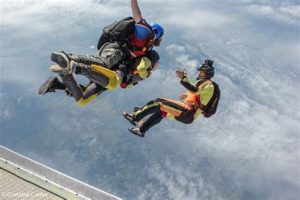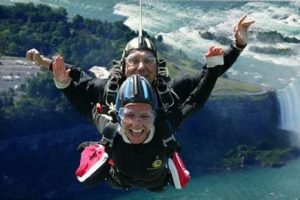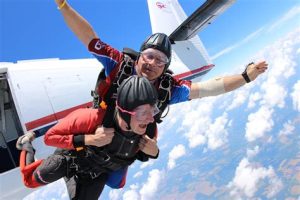Table of Contents
Discover the thrill of skydiving with our comparison of tandem and solo jumps. Tandem skydiving allows you to experience the rush of freefall while attached to an expert instructor. Solo skydiving, on the other hand, offers the ultimate adrenaline-charged adventure as you take control of your own parachute. Explore the pros and cons of both options to find the perfect skydiving experience for you.
Skydiving is an exhilarating and adrenaline-pumping sport that allows individuals to experience the thrill of freefalling from thousands of feet in the air. For those who are new to this extreme activity, there are two main options to choose from: tandem skydiving or solo skydiving. While both offer unique experiences, they differ significantly in terms of safety, training, and overall adventure. So, if you’re ready to take the plunge and want to know which option best suits you, let’s explore the contrasting features of skydiving tandem versus solo.
Skydiving Tandem Vs Solo
Welcome to the exciting world of skydiving! Whether you are a thrill-seeker or simply looking for a new adventure, skydiving offers an adrenaline rush like no other. However, before taking the plunge, it’s important to understand the differences between tandem and solo skydiving. In this article, we will explore the pros and cons of each option, helping you make an informed decision about which is right for you.
What is Tandem Skydiving?
Tandem skydiving is the most popular option for first-time skydivers. In this method, you are securely harnessed to a professional skydiver who will guide you through the entire experience. You’ll receive a brief training session before the jump, ensuring you understand the basics of body positioning and safety procedures.
The Tandem Skydiving Experience
The tandem skydiving experience begins with a thrilling plane ride to your designated altitude. As you reach the exit point, you’ll be connected to your instructor, and together, you’ll leap out into the open sky. During freefall, you’ll experience a rush of adrenaline as you plummet towards the ground at speeds of around 120 miles per hour.
Equipment and Safety
In tandem skydiving, the instructor is responsible for all the equipment, including the parachute and harness. This means you can focus solely on enjoying the experience without having to worry about technicalities. Rest assured, your instructor is highly trained and experienced, ensuring a safe and enjoyable jump.
Advantages of Tandem Skydiving
There are several advantages to choosing tandem skydiving as your first jump. Firstly, it requires minimal training, allowing you to experience the thrill of skydiving without extensive preparation. Additionally, the instructor takes care of all the technical aspects, providing a sense of security and peace of mind. Finally, tandem skydiving allows you to fully immerse yourself in the moment and enjoy the breathtaking views, as you don’t have to worry about operating the parachute or navigation.
Solo Skydiving: The Training Process
If you’re looking for a more independent skydiving experience, solo skydiving might be for you. However, before jumping solo, you’ll need to undergo comprehensive training. The training typically involves ground instruction, where you’ll learn about body positioning, emergency procedures, and how to deploy and control your parachute.
The Solo Skydiving Experience
Once you’ve completed the training, you’ll be ready for your first solo jump. This is an exhilarating experience as you take full control of your own skydive. From exit to landing, you’ll be responsible for every aspect of the jump. The feeling of independence and accomplishment can be incredibly rewarding.
Equipment and Safety
In solo skydiving, you are responsible for ensuring that all your equipment is properly maintained and functioning correctly. This includes your parachute, harness, and altimeter. You’ll also need to monitor weather conditions and make informed decisions about when it’s safe to jump. Safety is paramount in solo skydiving, and it is crucial to follow all protocols and guidelines.
Advantages of Solo Skydiving
Solo skydiving offers a unique sense of freedom and self-reliance. It allows you to challenge yourself mentally and physically, pushing your limits and boosting your confidence. Additionally, solo skydiving offers the opportunity to progress further in the sport, potentially leading to more advanced techniques and disciplines such as formation skydiving or wingsuit flying.
Choosing the Right Option
Deciding between tandem and solo skydiving ultimately depends on your personal preferences and goals. If you are seeking a thrilling one-time experience with minimal preparation, tandem skydiving is an excellent choice. On the other hand, if you are looking for a more independent and challenging journey, solo skydiving may be the route for you. Whichever option you choose, remember to prioritize safety, enjoy the breathtaking views, and embrace the adrenaline rush of this unforgettable adventure!
Skydiving Tandem vs Solo: A Guide for First-Time Jumpers
Welcome to the exhilarating world of skydiving! Whether it’s your first time taking the leap or you’re already an experienced jumper, it’s important to understand the differences between tandem and solo jumps. In this guide, we’ll compare the two options to help you make an informed decision.
Safety Considerations
When it comes to safety, both tandem and solo skydives have their pros and cons. Tandem skydiving offers a higher level of security as you’ll be harnessed to an experienced instructor who will guide you throughout the jump. On the other hand, solo skydiving allows you to take control of your own parachute deployment, but it requires extensive training and certification.
Experience and Skill Level
Tandem skydiving is perfect for those seeking an adrenaline rush without the need for any prior experience or training. It’s an ideal option for first-time jumpers who want to enjoy the thrill while having an expert by their side. Solo skydiving, however, is reserved for individuals who have completed the necessary training programs and have acquired the required skill set to jump without assistance.
Costs and Time Commitment
In terms of cost, tandem skydiving is generally more affordable since you’ll be sharing the experience with an instructor. It also requires less time commitment since the training and briefing for tandem jumps are relatively shorter. Solo skydiving, on the other hand, can be more expensive due to the required training courses, gear purchase, and licensing fees. Additionally, solo jumps may involve a longer training period to acquire the necessary skills.
Freedom and Independence
Tandem jumps offer a sense of security and let you enjoy the experience without worrying about the technicalities. The instructor handles all the critical aspects of the jump, allowing you to embrace the thrill. Conversely, solo skydiving enables you to experience the beauty of controlled freefall and gives you a greater sense of independence by allowing you to navigate your descent based on your skills and experience.
Time in Freefall
One of the noteworthy differences between tandem and solo jumps is the amount of time spent in freefall. Tandem jumps typically have a longer freefall duration as instructors are skilled at extending this portion for maximum enjoyment. Solo jumps, however, may have a comparatively shorter freefall time due to the nature of controlling one’s canopy descent.
Learning Opportunities
For those who aspire to become experienced skydivers, solo skydiving is the pathway to unlock a world of learning opportunities. It allows you to participate in advanced training programs, progress through different levels of skydiving licenses, and join a vibrant community of fellow solo jumpers. Tandem jumps, while thrilling, offer limited learning opportunities beyond the initial experience.
Personal Preference
Ultimately, the choice between tandem and solo skydiving boils down to personal preference. Consider your level of comfort, desired level of involvement, goals as a skydiver, and budget when making this decision. Whether you embark on a tandem jump or choose to venture into the world of solo skydiving, remember to embrace the incredible sensation of freefall and enjoy the ride!
When it comes to skydiving, there are two main options available: tandem skydiving and solo skydiving. Both experiences offer their own unique thrills and challenges, but they cater to different individuals with varied preferences and goals. Let’s explore the differences and benefits of each:
Tandem Skydiving:
Tandem skydiving involves jumping out of a plane while harnessed to an experienced instructor. This option is perfect for first-time skydivers or those who want to experience the rush of freefall without the need for extensive training. Here are some key points to consider:
-
Safe and Secure: Tandem skydiving provides a high level of safety as you have an experienced instructor guiding you throughout the entire process. They are responsible for managing the equipment, deploying the parachute, and ensuring a smooth landing.
-
Simplified Experience: With tandem skydiving, you can fully immerse yourself in the experience without worrying about the technical aspects. The instructor takes care of the logistics, allowing you to focus solely on enjoying the exhilaration of the jump.
-
Minimal Training: Tandem skydiving requires only a brief orientation session before your jump. The instructor will provide you with basic instructions and demonstrate the proper body position during freefall. This makes it accessible to anyone, regardless of their physical abilities or previous experience.
Solo Skydiving:
Solo skydiving, also known as accelerated freefall (AFF), is an option for those seeking a more independent and challenging skydiving experience. It involves a comprehensive training program that equips you with the necessary skills to jump solo. Here are some key points to consider:
-
Complete Freedom: Solo skydiving allows you to experience the thrill of skydiving on your terms. Once you’ve completed the training, you have the freedom to plan your jumps and navigate through the sky independently.
-
Sense of Achievement: Learning to skydive solo requires dedication and commitment. Overcoming the challenges of the training program and successfully completing your first solo jump can be an incredibly rewarding experience.
-
More Skills and Knowledge: In order to jump solo, you must undergo an extensive training program that covers various aspects of skydiving, including equipment management, body positioning, emergency procedures, and more. This knowledge not only enhances your safety but also allows you to become a more confident and competent skydiver.
Ultimately, whether you choose tandem or solo skydiving largely depends on your personal goals and preferences. Tandem skydiving offers an easy and accessible way to experience the thrill of skydiving, while solo skydiving provides a deeper level of immersion and independence. No matter which option you choose, both experiences offer an unforgettable adventure that will leave you with memories to last a lifetime!
Thank you for taking the time to read our blog post comparing the exhilarating experiences of skydiving tandem versus solo. We hope that you have found the information provided useful and insightful, and that it has helped you make an informed decision about which type of skydiving experience is right for you. Whether you choose to take the plunge on your own or with the guidance of a certified instructor, skydiving is an adventure like no other.
If you are a beginner and have never experienced the thrill of skydiving before, we highly recommend starting with a tandem jump. This option allows you to enjoy the incredible sensation of freefalling from thousands of feet in the air while securely harnessed to an experienced tandem instructor. The training process for a tandem jump is relatively quick and straightforward, making it accessible to individuals of all fitness levels and ages. You will receive a brief safety briefing, learn the basics of body positioning during the jump, and then be ready to soar through the sky. This is the perfect choice for those who want a taste of skydiving without the added pressure of navigating the jump on their own.
On the other hand, if you are seeking a more challenging and independent skydiving experience, then solo skydiving may be the right choice for you. However, it is crucial to note that this option requires a significant investment of time and commitment to training. You will need to complete a comprehensive skydiving course, which typically includes both classroom instruction and practical exercises. During this training, you will learn essential skills such as parachute control, emergency procedures, and landing techniques. While this option offers a greater sense of accomplishment and freedom, it is essential to carefully consider your abilities and comfort level before embarking on a solo skydiving journey.
In conclusion, whether you opt for a tandem jump or decide to pursue solo skydiving, both experiences offer an unparalleled rush of adrenaline and a chance to conquer your fears. Tandem skydiving provides a safe and enjoyable way to experience the thrill of freefalling while being guided by an experienced instructor. Solo skydiving, on the other hand, offers a more independent and self-reliant adventure. Whichever path you choose, always prioritize safety and follow the guidance of trained professionals. So gear up, take a leap of faith, and embrace the extraordinary world of skydiving!
Thank you once again for visiting our blog, and we hope to see you soaring through the skies soon!
.
When it comes to skydiving, many people have questions about the difference between tandem and solo jumps. Here are some commonly asked questions and their answers:
1. What is the difference between tandem and solo skydiving?
- Tandem skydiving involves jumping with an experienced instructor who is securely attached to you throughout the entire jump. It is a great option for beginners or those who want to experience the thrill of skydiving without extensive training.
- Solo skydiving, on the other hand, requires proper training and certification. You will be responsible for your own parachute deployment and landing.
2. Is tandem skydiving safer than solo skydiving?
- Tandem skydiving is generally considered safer because you have an experienced instructor guiding you throughout the jump. They handle all the technical aspects, allowing you to focus on enjoying the experience.
- Solo skydiving, while safe when proper training is followed, requires a higher level of skill and knowledge. It is important to undergo thorough training and stay up-to-date with safety practices.
3. Can I do a solo jump without any prior skydiving experience?
- No, you cannot do a solo jump without prior experience and certification. To jump solo, you must complete a training program offered by a certified skydiving school. The training covers essential skills, safety procedures, and emergency protocols.
- Once you have obtained the necessary certification, you can enjoy the freedom of solo skydiving.
4. How long does it take to learn solo skydiving?
- The duration of training to become a solo skydiver varies depending on the individual and the training program. It typically involves a combination of ground instruction, practice jumps, and classroom sessions.
- On average, it can take anywhere from a few days to a few weeks to complete the training and obtain the required certification.
5. Which option should I choose: tandem or solo skydiving?
- The choice between tandem and solo skydiving depends on your personal preferences, level of comfort, and goals.
- If you are new to skydiving or simply want to experience the thrill without extensive training, tandem skydiving is an excellent choice.
- However, if you are interested in pursuing skydiving as a hobby or dream of the ultimate freedom of jumping solo, then investing in solo skydiving training is the way to go.
Remember, whether you choose tandem or solo skydiving, always prioritize safety, follow instructions carefully, and enjoy the incredible experience of freefalling through the sky!






